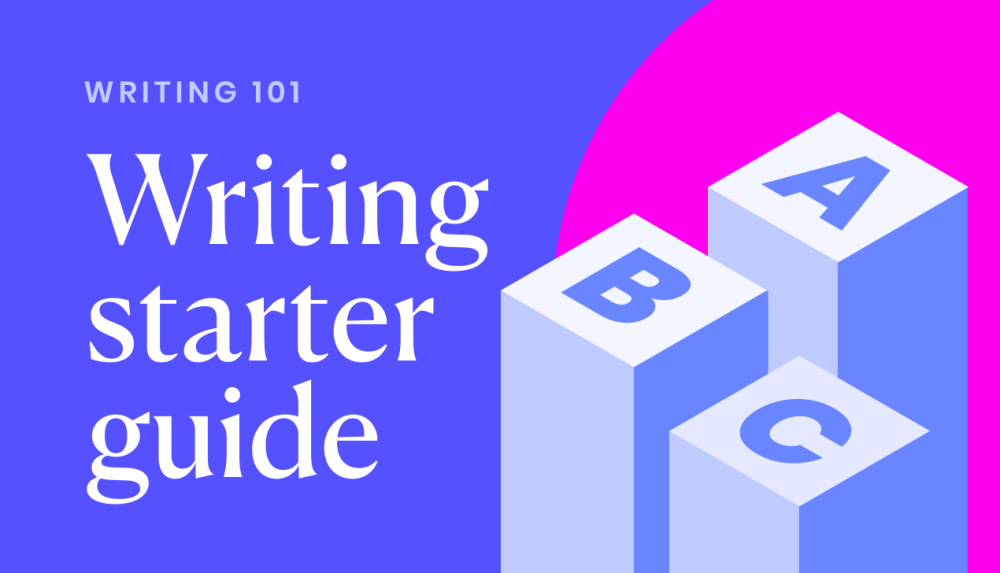
Words at work
– 8 min read
Writing starter guide: The basics

Everybody writes – there is a good chance you’ve written at least one thing today. Be it a tweet, an Instagram caption, an email, or a research paper.
However, there are two kinds of people in this world—the folks who like writing and the ones that would rather do anything else, including swimming with sharks, to avoid it.
We get it.
Staring at the blank page can be daunting. There’s a lot to consider and a lot of directions you could go. Where do you even begin?
Whether you’re looking to sharpen your skills as a student or pursue a career in writing, this post covers everything you need to know about the writing process, including:
What is writing?
In its most basic terms, writing is a way of communication. It’s an activity, occupation, or skill that uses words to express thoughts and ideas in a readable form. Writing can be informal or formal, written for personal enjoyment or an audience. There are many forms of writing and writing styles available, and each has its own rules and best practices.
No matter what style of writing you practice, you’ll need to understand the basics of grammar, sentence structure, punctuation, and vocabulary. Fortunately, these are all skills that can be taught and improved upon.
Before we dig into the different types of writing and tips for improving your style, let’s go back to the beginning.
In the next section, we’ll cover the history of writing systems so you can understand how we got to where we are today.
History of writing systems
From what we can tell, the earliest writing system came from Mesopotamia (aka present-day Iraq) nearly 5,000 years ago. Early pictorial symbols were replaced by a more complex system of characters representing local languages. The symbols initially read from top to bottom were transitioned to horizontal lines read left to right. This cuneiform writing system was used between 3400 and 3300 BC.
Though most agree that the first form of writing was born in the Mesopotamia region, it wasn’t the only area where early writing was taking place. Full writing-systems appeared independently of each other at least four times in human history.
Shortly after writing got its start in Mesopotamia, Egypt and the late Shang-dynasty China established their first writing systems. A bit later, writing systems started showing up in various cultures of Mesoamerica.
Though the dates these writing systems were started could indicate that writing as a form of communication started at a single point of origin, we can’t say for sure. There’s not much evidence to support this claim. As far as we know, writing systems have four unique starting points in human history. From these starting points, writing systems have grown into the rich writing types we enjoy today.
Types of writing
Writing has come a long way since its start in Mesopotamia. Not only are there thousands of languages, but there are many types of writing in existence. From leisure to business writing, there’s a type of writing for everyone now!
Here are six of the most common types of writing projects you could work on:
Narrative writing
Narrative writing, or story writing, is a type of writing that includes characters and a setting. It has a series of events, called the plot. This type of writing has a narrator or point of view from which the story is told. Examples of narrative writing include fairy tales, fiction novels, and plays with narrative plots.
Persuasive essays
Essays are nonfiction works that recount personal experiences or give an analysis of a particular issue or story. With a persuasive essay, the writer is attempting to get the reader to agree with their point of view. You would present research, arguments, data, and ideas to convince your audience. Essays can be published in many different publications or places.
Academic writing
Academic writing is a formal style of writing that includes research papers, dissertations, reports, and scholarly publications. This type of writing may follow a similar process as other types of writing, but academic writing has specific guidelines for structure, content, and style. In general, academic writing isn’t personal or emotive.
Copywriting
Copywriting is a type of persuasive writing for marketing and promotional materials. The goal of copywriting is to motivate people to take action, such as donating, purchasing, or scheduling a meeting. The text is often referred to as copy or sales copy. The writer is called a copywriter.
Content writing
Content writing is a category of work that involves planning, writing, and editing web content. This type of marketing content includes blog posts, articles, podcast or video scripts, specific platform content like LinkedIn articles, and more.
Poetry
Poetry is a form of creative writing that uses aesthetic and rhythmic qualities of language to show meaning or emotion. Poetry can be a great creative outlet for all types of writers.
Tips to improve your writing skills
Many people make the mistake of thinking that when it comes to writing talent, you either have it in you or you don’t. Nothing could be farther from the truth! Writing is a learnable skill. And you can improve your skills with a bit of work.
Here are five tips to help you hone your writing chops, no matter what style of writing you do.
Practice, practice, practice
It’s no secret that the best way to get better at writing is to just do it. Keep practicing to sharpen your skills. The more you write, the better you’ll get.
In fact, it can be helpful to participate in a daily, weekly, or monthly challenge – such as Nanowrimo – where you write a certain amount of words each day.
• Keep a journal and jot down your daily thoughts.
• Join a group that tackles writing prompts together.
Whatever gets you writing, run with it. But most importantly, you need to stick to it.
Editor’s Note: Want to be a more efficient writer? Check out these writing tools.
Start with smaller projects
You wouldn’t run a marathon without training beforehand. Why would you tackle a major writing project without working on smaller ones first? Practice your writing with smaller projects to prepare yourself for the more complicated ones.
This will look different depending on the type of writing you do.
• For example, content writers can start by writing social media captions before writing full, longform articles.
• A nonfiction writer could try their hand at a longform blog post before trying to write a New York Times bestseller.
• A fiction writer could write a short story before they start on their novel.
If you find yourself working on a bigger project, one way to avoid writer’s block is to do some pre-writing first. This can come in the form of an outline or an ugly first draft. The goal is to get everything out of your head and onto paper or your computer screen.
Practicing on smaller projects will save you from burnout or heavy editing on the larger ones.
Read as much as you can
Read anything and everything you can get your hands on. You never know where inspiration will strike you next.
The writing you like on one medium can often be applied to another.
For instance, a clever print ad could give you an idea for a podcast script you’re writing. An Instagram post might spark an idea for the next blog topic.
Keep reading to expose yourself to as many new ideas as possible.
Pro Tip: Pay attention to the stylistic choices that your favorite writers make in their writing.
Shoot for clear and concise
New writers often make the mistake of adding too much detail or lengthy language. Instead, keep your writing clear and simple.
This is true no matter what you write, whether that’s fiction, sales copy, or anything in between.
Using clear, correct language makes the piece more enjoyable and readable by your audience.
Proofread your work
One of the simplest ways to level up your writing is to follow basic grammar rules. You don’t need to channel your middle school English teacher and attack your writing with a red pen. However, you should use spell check, write in complete sentences, and avoid silly punctuation errors.
Pro Tip: Want to level up your writing? Sign up for a free trial of Writer here.
***
No matter what type of writing you want to pursue, keep working at it and take the time to practice. You will become a better writer. And most importantly, enjoy it!







